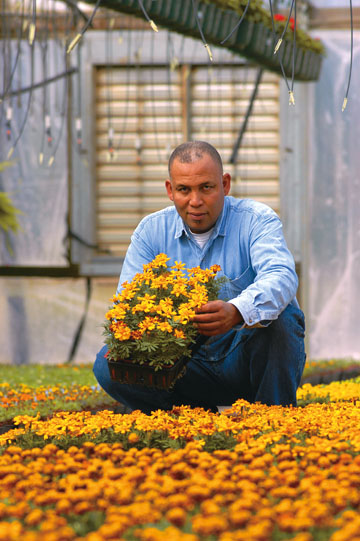Watering the Right Way

With rainfall across most of Alabama at least 10 inches below normal already this year, homeowners and gardeners may think their only choice is between a brittle, dusty landscape and soaring water bills. But that’s not the case.Flowers, shrubs and grass can be kept lush and beautiful during summer months by watering as little as eight minutes every third day, according to a brochure supported by state agencies and the Alabama Nursery and Landscape Association.”The idea that you shouldn’t buy plants or try to have a beautiful garden or lawn during dry weather is a myth,” said Brian Hardin, director of the Alabama Farmers Federation’s Greenhouse, Nursery and Sod Division. “In fact, maintaining a healthy landscape may actually reduce energy costs and improve the environment if we learn to use water wisely.”One of the biggest problems, however, is that people often water too frequently for short periods of time, he said. This “surface watering,” encourages roots to stay shallow; whereas infrequent but regular deep watering will guide roots farther into the soil, where they can seek out moisture.”An inch a week is all it takes,” Hardin said. “Deep, less-frequent watering promotes healthy root systems that can better withstand dry spells.”Other water conservation practices include: controlling weeds that compete for water and nutrients; watering trees and shrubs separately because they require less water than lawns; adding a rain switch to sprinkler systems to avoid double watering; collecting rainwater in containers for potted plants; watering in early morning and late evening when evaporation is less; and checking sprinklers and hoses for leaks.For those who still question whether it’s smart to try gardening during a drought, the brochure offers some eye-opening facts about how healthy landscapes help the environment.For starters, one tree can remove 26 pounds of carbon dioxide each year from the air and release 13 pounds of oxygen daily, enough for a family of four. Shade trees also reduce energy consumption, and on a hot day, lawns will be 30 degrees cooler than nearby pavement. Add to this the fact that landscaping adds 7 to 15 percent to the value of real estate, and it’s easy to see why environmental and agriculture groups alike are encouraging wise watering.Those supporting the brochure titled “Think you can’t buy plants during a dry spell? You can,” include the Alabama Nursery and Landscape Association, the Alabama Cooperative Extension System, the Alabama Department of Environmental Management and the Alabama Soil and Water Conservation Committee. In addition to tips on watering, the colorful brochure offers advice on mulching, which not only helps the soil retain moisture but also prevents runoff and discourages weeds. In general, the brochure calls for no more than 2-3 inches of mulch — leaving enough space around plants, trees and shrubs so excess water doesn’t accumulate and promote rotting.For help in selecting plants that are drought hardy, contact your local extension system or local garden center.To get started with a water-wise conservation plan for the lawn or garden, experts suggest scattering shallow metal cans around the yard before turning on the sprinklers. Water for 15 minutes; then measure the amount of water in each can. The helpful “Lawn Watering Guide” chart will then tell you how many minutes to water every third day based on the amount of water in the cans.For a copy of the brochure, visit the Alabama Farmers Federation Website at www.AlfaFarmers.org and click on Commodities, then Greenhouse, Nursery and Sod.
